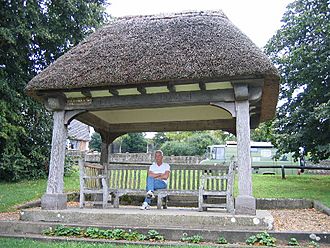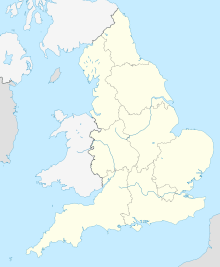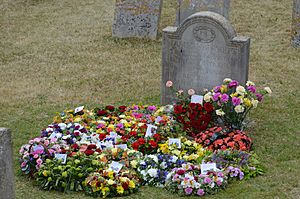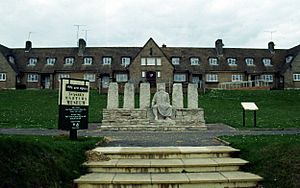Tolpuddle Martyrs facts for kids

The shelter in Tolpuddle erected as a memorial in 1934
|
|
| Date | 1833–1834 |
|---|---|
| Location | Tolpuddle, Dorset, England |
| Participants |
|
| Outcome |
|
The Tolpuddle Martyrs were six farm workers from the small village of Tolpuddle in Dorset, England. In 1834, they were found guilty of swearing a secret promise as members of a group called the Friendly Society of Agricultural Labourers. They were arrested during a disagreement about their low wages and were sent far away to Australia as punishment. This was called penal transportation.
After big protests and support from important people, they were forgiven in 1836. They started returning to England between 1837 and 1839. The Tolpuddle Martyrs became famous symbols for early trade unions and movements fighting for workers' rights.
Contents
The Story of the Tolpuddle Martyrs
Why the Workers Formed a Union
Back in 1799 and 1800, laws called the Combination Acts made it illegal for workers in Britain to team up or organize to get better working conditions. These laws were passed by Parliament because leaders were worried after the French Revolution. In 1824, these unpopular laws were removed. New laws allowed trade unions, but they still made it very hard for unions to do much.
By the early 1800s, farm workers in Dorset county were paid very little. After the Napoleonic Wars ended in 1815, many people needed help from the government because they were so poor. Things got even worse for farmers. By 1830, conditions were so bad that many workers joined the Swing Riots. These were protests across southern England where workers broke machines and demanded better pay. Some landowners did raise wages for a short time, but many workers were arrested, and soon wages went back down.
In 1833, six men from Tolpuddle decided to do something about their low pay. They started the Friendly Society of Agricultural Labourers. This group was like a friendly society that also worked as a benefit society for farm workers. They wanted to stop their wages from being cut even more. Workers in Tolpuddle were refusing to work for less than 10 shillings a week, but their pay had already dropped to seven shillings and was about to go down to six.
The group was led by George Loveless, who was a local preacher. They met at Thomas Standfield's house. Groups like theirs often had a special way to welcome new members. A new member would be blindfolded and promise to be loyal to the group. Then, the blindfold would be taken off, and they would see a painting of a skeleton. This was to remind them that life is short and that they should keep their promises. You can see an example of such a skeleton painting at the People's History Museum in Manchester.
Arrest and Punishment
In 1834, James Frampton, a local landowner and important official in Tolpuddle, complained to the government about the union. He wrote to the Home Secretary, Lord Melbourne. Lord Melbourne suggested Frampton use an old law called the Unlawful Oaths Act 1797. This law was made after some navy sailors protested and it made it illegal to swear secret promises.
So, the members of the Friendly Society were arrested. These were James Brine, James Hammett, George Loveless, George's brother James Loveless, George's brother-in-law Thomas Standfield, and Thomas's son John Standfield. They were all tried together by Judge Sir John Williams. All six were found guilty of swearing secret oaths and were sentenced to be sent away to Australia for seven years.
When George Loveless heard his sentence, he wrote down some lines from a union song called "The Gathering of the Unions":
God is our guide! from field, from wave,
From plough, from anvil, and from loom;
We come, our country's rights to save,
And speak a tyrant faction's doom:
We raise the watch-word liberty;
We will, we will, we will be free!
Journey to Australia and Return Home
Five of the men – James Loveless, the two Standfields, Hammett, and Brine – sailed on a ship called the Surry to New South Wales in Australia. They arrived in Sydney on August 17, 1834. George Loveless was sick and left later on a ship called the William Metcalf for Van Diemen's Land (which is now Tasmania). He arrived in Hobart on September 4.
In Australia, the men were made to work for free settlers (people who had moved there) on farms. Brine and the Standfields worked in the Hunter Valley. Hammett worked on a farm in Queanbeyan, and James Loveless worked on a farm at Strathallan. George Loveless worked on the farm of the Lieutenant Governor, Sir George Arthur, in Hobart.
Back in England, the Tolpuddle Martyrs became very popular heroes. People collected 800,000 signatures asking for their release. Their supporters also organized a big political march, which was one of the first successful marches in the United Kingdom. Because of all this support, they were all forgiven in March 1836, as long as they behaved well. Lord John Russell, who had just become the Home Secretary, also helped them.
When George Loveless received his pardon, there was a delay because he didn't know if his wife would join him in Van Diemen's Land. Finally, on December 23, 1836, he got a letter saying she wasn't coming. He sailed from Van Diemen's Land on January 30, 1837, and arrived back in England on June 13, 1837.
The other men in New South Wales also had delays getting home. It took time for officials to confirm their good behavior and release them from their work. James Loveless, Thomas and John Standfield, and James Brine left Sydney on the ship John Barry on September 11, 1837. They reached Plymouth in England on March 17, 1838. There is a special plaque in Plymouth that remembers their arrival. James Hammett was held back in Windsor, Australia, because he was accused of an attack. He didn't sail until March 1839 and arrived in England in August 1839.
Life After Returning Home
When they first returned from Australia, the Lovelesses, Standfields, and Brine settled on farms near Chipping Ongar, Essex. The Lovelesses and Brine lived at Tudor Cottage in Greensted Green. Later, five of them moved to the town of London, in what was then called Upper Canada (now Ontario, Canada). Today, there is a monument there in their honor, and a special housing complex for workers is named after them. George Loveless and Thomas Standfield are buried in Siloam Cemetery in London, Ontario. James Brine died in 1902 and is buried in St. Marys Cemetery, St. Marys, Ontario.
James Hammett returned to Tolpuddle and later died in the Dorchester workhouse in 1891.
Museums and Memorials
The Tolpuddle Martyrs Museum in Tolpuddle, Dorset, has exhibits and interactive displays about the martyrs and how they influenced trade unions. The Shire Hall in Dorchester, where the Tolpuddle Martyrs were tried, is now also a museum that includes information about them.
A monument was built in Tolpuddle in their honor in 1934. A sculpture of the martyrs, made in 2001, stands in the village in front of the Tolpuddle Martyrs Museum.
Every year, the Trades Union Congress (TUC) organizes the Tolpuddle Martyrs' Festival in July. It includes a parade with banners from many trade unions, a special memorial service, speeches, and music. Famous speakers and musicians have attended these festivals.
The courtroom in Dorchester's Shire Hall where the martyrs were tried looks much like it did 200 years ago. It is being preserved as part of a historical project.
The story of the Tolpuddle Martyrs is a very important part of the history of trade unions. People still discuss how important their story is, starting from when Sidney and Beatrice Webb wrote their book History of Trade Unionism in 1894.
Several places are named after the Tolpuddle Martyrs:
- Tolpuddle Street, Islington, London
- Tolpuddle Way, Kirkdale, Liverpool
- Tolpuddle Vineyard, Richmond, Tasmania
In 1984, a large painting (mural) was created in London to remember the big gathering of people who protested against the Tolpuddle Martyrs being sent to Australia. The artist was David Bangs.
In 1985, a special plaque for the Tolpuddle Martyrs was put in Garema Place in Canberra, the capital city of Australia.
The film Comrades from 1986 tells the story of the Tolpuddle Martyrs using the pictures of a traveling lanternist. A play based on this film was performed in 2023, telling their story up to their arrest.
A musical drama called 'Tolpuddle' was broadcast on BBC Radio 4 in 1982. The Tolpuddle Martyrs are also mentioned in a poem by Daljit Nagra.
A new plaque by artist Clifford Harper was put up in Plymouth in March 2020 to remember the men who returned there from Australia.
Images for kids
See also
- Chartism
- Convicts in Australia
- Enclosure
- Peterloo Massacre
- UK labour law










